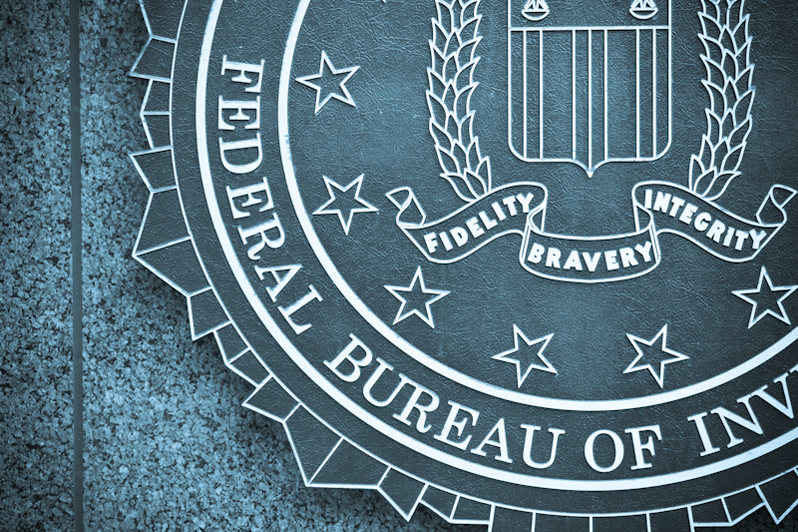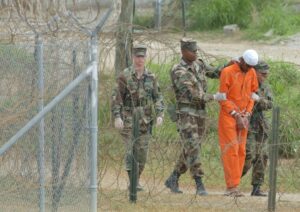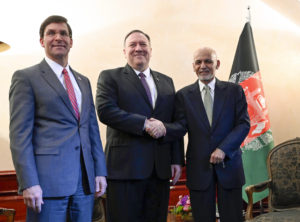Are Media Exaggerating ‘Reformed Terrorist’ Story to Advance FBI’s Disturbing Agenda?
There are serious questions about the story extremist-turned-FBI-informant Jesse Morton told reporters. Dave Newman / CC BY 2.0
Dave Newman / CC BY 2.0
By Sarah Lazare / AlterNet
U.S. media outlets are eagerly broadcasting the supposedly redemptive story of Jesse Morton, a Pennsylvania-born former “Al Qaeda recruiter” turned FBI informant and counter-terror expert, transformed into a force for good thanks in part to his run-ins with federal agents. The 37-year-old Morton’s story is capturing attention because he was recently hired as a fellow at George Washington University’s Program on Extremism, which functions as a feeder school and think tank for the federal war on terror and domestic surveillance apparatus. In his new position, Morton will, as New York Times reporter Rukmini Callimachi put it, “research the very ideology he once spread.” Lorenzo Vidino, the director of the GW program, boasts that this is the first time a former jihadist will take an academic post in the United States.
In addition to the Times article, titled, “Once a Qaeda Recruiter, Now a Voice Against Jihad,” Morton was featured in an interview on PBS news hour and covered by publications from CNN to the Washington Post. Each of these stories is remarkably similar, echoing Morton’s narrative of being “rehumanized” by an FBI agent and reformed by reading western philosophers and writers like John Locke and Jean-Jacques Rousseau. Reporters overwhelmingly take Morton’s story of “de-radicalization” at face value, failing to raise the most basic questions about the federal agents he lauds.
It is easy to understand why the FBI would be thrilled with the positive media coverage its informant program has received, thanks to Morton. The program has been subjected to lawsuits and accusations of gross human rights violations, including mistreatment of the people it coerces into cooperation. It is also worth questioning whether Morton’s story, as it is being told by major media outlets, is entirely true.
A closer look at Morton’s story raises serious questions about his past and the way it has been exploited. Two expert researchers who interviewed Morton before his conviction describe him as a provocateur who had little influence and no operational role in Al Qaeda. With the help of self-styled national security reporters, Morton may be exaggerating his past to advance his career ambitions, while providing the FBI with desperately needed public relations help.
Prolific Al Qaeda Recruiter or Provocateur?
Morton says he was propelled toward extremism by the abuse he endured during his early childhood. After running away at the age of 16 to follow a Grateful Dead tour, he allegedly first came into contact with Islam in 1999 via a man he was selling drugs with at a concert. The man “instructed him to repeat a string of Arabic words” as police were closing in, writes Callimachi, adding, “Only later did he realize he had recited the declaration of Muslim faith.”
When Morton was jailed in a Richmond, Virginia prison for allegedly selling narcotics, he reportedly shared a cell with an older Moroccan Muslim who gave him the name Younus, and he says he embarked on a path to radicalization after that point. “It gave me an outlet to have meaning, to have purpose, but it also gave me an outlet to express my rage and my frustration,” he told CNN.
In 2007, Morton co-founded Revolution Muslim, which Callimachi describes as “a relay station for Al Qaeda’s broader message.” According to Callimachi, “In the four years that he ran the Revolution Muslim website out of his walk-up apartment in Flatbush, Brooklyn, Jesse Morton became one of the most prolific recruiters for Al Qaeda, luring numerous Americans to the group’s violent ideology.” She continues:
The men and women he inspired through his online posts and tutorials were accused of plots that included flying a remote-controlled plane strapped with explosives into the Pentagon and trying to kill a Swedish cartoonist who satirized the Prophet Muhammad. One of his collaborators was killed in a drone strike in Yemen, where he had joined Al Qaeda in the Arabian Peninsula. Several are now fighting for the Islamic State.
To underscore Morton’s past as a hardened terrorist, Callimachi quotes Mitch Silber, who was former director of intelligence analysis for the New York Police Department and was allegedly involved in monitoring Morton. “Revolution Muslim was a bug light, which attracted aspiring jihadists with their message,” Silber told Callimachi.
What is not mentioned in the article is that Silber is a fierce advocate of the NYPD’s post-9/11 spying program targeting Muslim communities in and beyond New York with suspicionless surveillance and ethnic/religious profiling, forcing the department to eventually settle two civil rights lawsuits. After Associated Press reporters won the 2012 Pulitzer Prize for investigating the mass surveillance, Silber published articles vigorously defending the surveillance, using the case of Morton to justify spying on universities and colleges. In light of this, Silber has an interest in presenting Morton as a dangerous terrorist, yet this context is missing from the reporting of Callimachi, who declined a request for an interview from AlterNet because she is traveling overseas on assignment.
CNN reporter Elizabeth Cohen echoes Callimachi’s narrative, describing Morton as an Al Qaeda “member” and “one of the group’s chief propagandists and recruiters.” Yet according to Arun Kundnani, author of The Muslims Are Coming! Islamophobia, Extremism, and the Domestic War on Terror, an adjunct professor at New York University and a leading expert on domestic counter-terror programs, this narrative reflects shoddy journalism.
“[Morton] wasn’t a recruiter for Al Qaeda,” said Kundnani, who interviewed Morton in 2011. “He wasn’t a recruiter for any terrorist organization. He was someone who expressed a worldview online that was absolutist, and he was a fan of Osama bin Laden. I have never seen any evidence that he actually functioned in any way as a recruiter for Al Qaeda. He was certainly someone who expressed views sympathetic to them, but there is a distinction between those two.”
“No doubt it’s true that you could find people who were terrorists who, at some point, looked at his website,” Kundnani continued. “That is not the same as being a recruiter. That is not the same as causation. There are going to be thousands of websites these people visited. That does not establish cause and effect.”
An FBI press release from 2012 indicates that Morton’s conviction related to his role in publishing materials online and communicating with associates. It states that he “pleaded guilty today to using his position as a leader of Revolution Muslim Organization’s Internet sites to conspire to solicit murder, make threatening communications, and use the Internet to place others in fear.”
Morton, for his part, says he would also go stand outside of mosques to recruit, telling Callimachi, “We were looking for lions and left them the lambs.”
Trevor Aaronson, the author of The Terror Factory: Inside the FBI’s Manufactured War on Terrorism and contributor to The Intercept, told AlterNet he does not buy “the idea that Morton was some kind of hardcore terrorist.” Aaronson, who met Morton during the fall of 2009 in New York, said, “He always struck me as more of a provocateur than terrorist. He would go on street corners and say extremist things and try to encourage people to get involved, but he was never involved in terrorism or violence. He was just a different type of extremist. He ended up being more of a loudmouth than a man of action.”
Morton declined a request for an interview, and AlterNet was unable to determine the veracity of his full statements about his life story or motivations behind them. But at the very least, reporters’ assertions that he was “one of the most prolific recruiters for Al Qaeda” or a “member” of the militant organization appear to be overblown.
Morton appears to have actively encouraged this media narrative by emphasizing his violent past, telling Callimachi, “As many people as may have traveled, or may have committed criminal acts, because of my words, I hope that I can deter just as many. I may never be able to repair the damage that I have done, but I think I can at least try.”
Kundnani says that Morton could have an incentive to “exaggerate his past to establish credibility as a counter-radicalizer.”
“The character of the former extremist has been used in Britain,” Kundani continued, referencing the case of Maajid Nawaz, who has risen to prominence, and received high levels of funding from the British government for his Quilliam Foundation, by presenting himself as an expert on de-radicalization. As Nafeez Ahmed and AlterNet senior editor Max Blumenthal revealed in February, Nawaz’s own story about his journey from extremism to redemption has been questioned by his immediate family members and close associates, who say it is filled with exaggerations, distortions and outright lies.
In a Twitter storm promoting her article, Callimachi directly referenced Nawaz, stating: “Until today, there were no such examples in the US.”
While he was living in Morocco, Morton was arrested in 2011 by American authorities and brought to the United States to face charges. According to media coverage of his arrest and detention, his interactions with law enforcement authorities and exposure to Western literature fostered his reform.
Callimachi writes:
He recounted being driven to a deserted airport, where he clutched his Quran as a team of United States agents handcuffed, shackled and blindfolded him. Before placing earphones over his ears, they took away his Quran.
He was surprised when one of the agents removed the blindfold midflight and handed him back the holy book. It was the first of several gestures that he said would touch him, a step along what he described as a long, gradual path out of radicalization.
According to the CNN’s Cohen, “In prison he spent time in the library, where he read the works of Enlightenment philosophers Jean-Jacques Rousseau and John Locke, and American thinkers such as Thomas Paine,” allowing him to “re-identify with Western culture and civilization.”
The CNN story goes on to state that Morton “met a ‘fabulous’ FBI agent who would change his life. While other law enforcement officers ‘demonized’ him, Morton said this agent showed him respect—and that changed his entrenched views that the U.S. government was evil.”
In the Washington Post, reporter Susan Svrluga touched on the same theme, reporting, “When he met with law enforcement to work on his plea bargain, there was a female agent whom he said ‘rehumanized me.’”
Morton worked as an informant for the FBI, a role that led to a significant reduction in the 11.5 year sentence he was handed in 2012, cutting it to three years and nine months. The details of his cooperation with federal agents were first exposed in February by Washington Post writer Matt Zapotosky, who wrote: “Information about Morton’s release and work as an informant spilled into public view Jan. 27, when an attorney for a man in Woodbridge, Va., who was charged last month with helping a friend try to join the Islamic State identified Morton using an alias in open court.”
According to an affidavit in the Woodbridge case, Morton was paid more than $10,000 by the FBI, Zapotosky reports. But it is not immediately clear exactly when Morton’s role as an informant began.
In an interview with PBS, Morton drew on his own personal history of childhood abuse to argue, “When we study pre-radicalization, we oftentimes see trauma, we see criminality, we see that the radical or violent extremist interpretation of Islam attracts people with some degree of baggage.”
The statement appears to be a direct nod to theories of radicalization underlying federal programs like Countering Violent Extremism, which are based on the assumption that inherent risk factors like marginalization, trauma and poverty make people more inclined toward terrorism, with clear and fixed markers of radicalization along the way. This theory has been debunked by scholarly consensus, and even an academic study directly supported by the Department of Homeland Security, which holds that there is no single or simple profile for a terrorist. However, the unproven theory undergirds federal surveillance programs, including recent FBI guidelines for monitoring and reporting students in public schools across the country.
“His narrative is a positive one for the FBI,” said Aaronson. “It’s this idea that people are radicalized but can be de-radicalized, and that for god and country, people who see the light can work as FBI informants and turn their lives around for the better.”
‘The FBI Is Not a Social Welfare Agency’
After the attacks of 9/11, the FBI’s informant program exploded in size, with the agency revealing in 2008 that it had 15,000 informants on its payroll. But according to the Center for Constitutional Rights, this number could be far higher, because it “doesn’t include number of unofficial informants they use, which may be triple the number of official informants.” To give a sense of scale, under the COINTELPRO operations overseen by J. Edgar Hoover, the number of informants was 1,500.
This informant program has left behind a trail of individuals who say they were unfairly coerced into becoming informants and/or mistreated when they cooperated.
In November 2004, a man who had worked as a federal informant on terrorism set himself on fire in front of the White House to protest how the FBI handled his case. Mohamed Alanssi, who was 52 years old and survived the incident, told the Washington Post that the FBI was holding his Yemeni passport to compel him to testify at a terrorism trial in New York, preventing him from seeing his sick wife. Journalists Caryle Murphy and Del Quentin Wilber wrote that Alanssi “also was upset with the FBI because he said agents had not kept promises they made to secure his cooperation. Those promises included a large, but unspecified, amount of money, eventual U.S. citizenship and protection of his identity, he said.”
“It is my big mistake that I have cooperated with FBI,” Alanssi told the Post. “The FBI have already destroyed my life and my family’s life and made us in a very danger position.”
As recently as August, a Charlotte, North Carolina man named Erick Jamal Hendricks who is accused by federal prosecutors and the FBI of assisting recruitment for the Islamic State, claimed he had in fact been working as an informant for the FBI since 2009 under the code name Ahkie.
“In his jail statement, Hendricks says he was recruited in 2009 by an FBI agent named David to help identify potential terrorists,” wrote Charlotte Observer journalists Michael Gordon and Mark Washburn. “In 2010, after Hendricks had moved to Columbia, he says he worked with another FBI agent named Steve. Altogether, Hendricks claims to have developed ‘at least a half-dozen’ cases against extremists.”
“I have publicly, privately and consistently denounced Al-Qaeda, ISIS and all extremist groups,” Hendricks said in a statement. “I am baffled as to why the FBI (is) accusing me of terrorist ties.”
Those unwilling to become informants face retaliation and threats. In the lawsuit Tanvir v. Holder, four Muslim plaintiffs charged that the FBI put them or kept them on the secretive federal no-fly list in retaliation for their refusal to inform on their communities.
“Individuals have recounted how the FBI threatened them with baseless terrorism charges or deportation to gain their cooperation, or have brought charges against them in retaliation for their refusal to work as an informant,” explains the Center for Constitutional Rights, noting that it is difficult to calculate the exact extent of this coercion.
Under this massive program, informants play a critical role in entrapping those individuals targeted. Human Rights Watch concluded in a 2014 study that “nearly 50 percent of the federal counterterrorism convictions since September 11, 2001, resulted from informant-based cases. Almost 30 percent were sting operations in which the informant played an active role in the underlying plot.” The organization notes that discriminatory investigations often target “particularly vulnerable individuals (including people with intellectual and mental disabilities and the indigent), in which the government—often acting through informants—is actively involved in developing the plot, persuading and sometimes pressuring the target to participate, and providing the resources to carry it out.”
This critical background has been omitted from the media narrative of Morton, who has instead emerged as a poster boy for an FBI informant program that supposedly helped him better his life and correct the wrongs of his past.
But as Aaronson put it, “There are 15,000 informants, and most of them are not working for the FBI because they want to turn their lives around. They have been coerced. The coverage of Jesse Morton’s case has been poor for not providing that context. The narrative has been overly simplistic and doesn’t acknowledge that the FBI is not a social welfare agency looking to set people on a good path. It is law enforcement and it will use and abuse people.”
Your support matters…Independent journalism is under threat and overshadowed by heavily funded mainstream media.
You can help level the playing field. Become a member.
Your tax-deductible contribution keeps us digging beneath the headlines to give you thought-provoking, investigative reporting and analysis that unearths what's really happening- without compromise.
Give today to support our courageous, independent journalists.






You need to be a supporter to comment.
There are currently no responses to this article.
Be the first to respond.